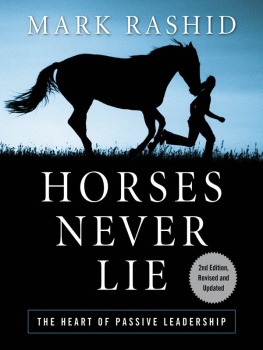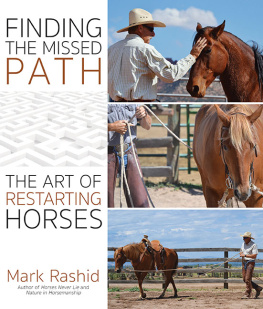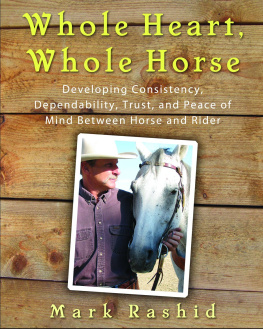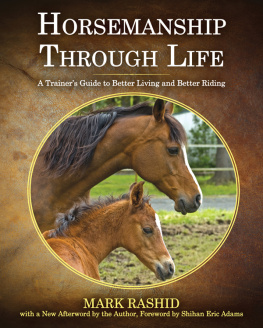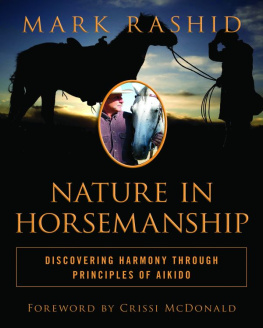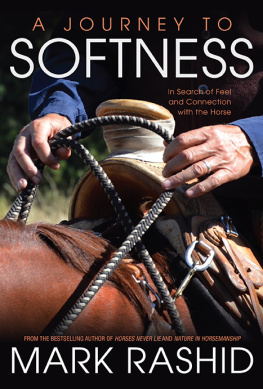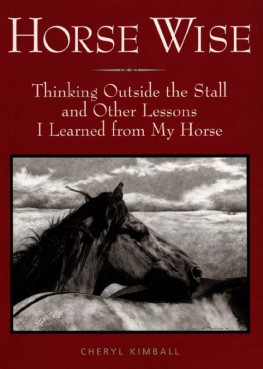Horses
Never Lie
2nd Edition

Also by Mark Rashid
A Good Horse Is Never a Bad Color
with Illustrations by Herb Mignery
Considering the Horse:
Tales of Problems Solved and Lessons Learned
with Illustrations by Ron Ball
Whole Heart, Whole Horse:
Building Trust Between Horse and Rider
Horses
Never Lie
2nd Edition
The Heart of Passive Leadership
Mark Rashid

Skyhorse Publishing
Copyright 1993, 2011 by Mark Rashid
Illustrations: Ron Ball
All Rights Reserved. No part of this book may be reproduced in any manner without the express written consent of the publisher, except in the case of brief excerpts in critical reviews or articles. All inquiries should be addressed to Skyhorse Publishing, 307 West 36th Street, 11th Floor, New York, NY 10018.
Skyhorse Publishing books may be purchased in bulk at special discounts for sales promotion, corporate gifts, fund-raising, or educational purposes. Special editions can also be created to specifications. For details, contact the Special Sales Department, Skyhorse Publishing, 307 West 36th Street, 11th Floor, New York, NY 10018 or info@skyhorsepublishing.com.
Skyhorse and Skyhorse Publishing are registered trademarks of Skyhorse Publishing, Inc., a Delaware corporation.
www.skyhorsepublishing.com
10 9 8 7 6 5 4 3 2 1
Library of Congress Cataloging-in-Publication Data is available on file.
ISBN: 978-1-61608-241-3
Printed in China
For all the people around the world that have allowed me the great honor
of working with them and their horses.


My first exposure to Mark Rashid cost me a good nights sleep. It was a Thursday evening in late 1997 and I was to record a radio interview with him the following morning on his first book, Considering the Horse. I figured an hour or so would be enough to get up to speed on his training methods and to scribble out a few insightful questions on my beat-up yellow pad. So I settled at my desk, opened the book, and launched into skimming mode. Now, Ive gotten pretty good at skimming, and most horse-training books lend themselves to that since theyre written like textbooks. This book was different, however, and before I realized it, I was hooked. I read into the wee hours of Friday morning and forgot all about my yellow pad.
I read every word of that book, then later, its sequel, A Good Horse is Never a Bad Color, as well as the book you now hold in your hands, which Mark was kind enough to send me, chapter-by-recently-completed-chapter, via e-mail. Ill admit it: Im a fan.
Mark Rashid is a unique and thoughtful horse trainer whose insistence on considering the horses point of view is producing remarkable changes in horses and the people who love them. Hes also a fine storyteller who manages to weave the horsemanship principles he espouses seamlessly into engaging anecdotes taken from his own life, especially his boyhood tutelage under a grizzled old horseman he refers to simply as the old man. I suspect that you will find yourself, as I have, reliving in Marks stories your own youth, a time that could be bittersweet, confusing, and exhilarating, all on the same day.
Mark Rashid bases his gentle, non-assertive horse-training philosophy on the passive leader, the horse in the herd who leads by example rather than force. Ive noticed that this is a good description of the man himself. Mark will not force his methods down your throat any more than he would force them on a horse. Hell simply lay out the choices as he sees them and let you decide for yourself.
Take it from an expert. This is not a book for skimming. Youll want to keep it on your nightstand, savor every word, and dream sweet, horsey dreams. Who knows? You may wake up a better horseman, and a better person.
Rick Lamb
The Horse Show, syndicated radio program

Back in the spring of 1996, I was asked to give a lecture for the Pacific Northwest Endurance Riders Convention that was to be held in Oregon. The subject matter for the lecture was left up to me, but the organizer mentioned that she felt a lot of the folks who were going to attend might be interested in hearing about how I work with troubled horses.
I gave the idea a great deal of thought before finally sitting down at the computer and trying to jot down some notes. For some reason, I was having a very difficult time getting my thoughts together for the speech, and it took me nearly six months to get an outline down on paper. Even at that, I still wasnt overly excited about what I had written. I had given so many talks on troubled horses over the years that I couldnt help but feel like I would be repeating myself by giving this talk. Even so, it was what they wanted to hear, so I figured I would go on ahead and give the talk as I had outlined it.
I was to give the speech around mid-February of 1997 and had only finished my notes on it a few weeks before. It had been like pulling teeth getting them done, and I was happy to have that part of it over.
Now, I never was much good with computers and certainly didnt have a real good understanding of how they work. I had no idea that when you saved things on a computer, you were supposed to back up the file to a disk, so that if the computer ever crashed, the information that you had been working on for months wouldnt be lost. I just figured that once the information went into the computer, you would always be able to get it back out, no matter what. After all, the information was going into a box, and logic says that if you put something into a box, you should be able to get it back out. Unfortunately, I was soon to find out that my idea of how computers work is not in any way, shape, or form the same idea that the computer has.
One afternoon we had a pretty bad windstorm that knocked out the power on the ranch. When the power came back on, the computer didnt. Not only did it not come back on, but everything that had been inside it when the power went off was lost to the ages. The notes that I had agonized over all those months had disappeared somewhere inside those tiny little circuits, never to be seen again.
With the date of my speech rapidly approaching, I sat down and tried to recreate my notes. It was no use. The harder I tried to write, the more my mind wandered, until I finally gave up on the idea of talking about troubled horses and began thinking about something else entirely.
The thing that my mind kept coming back to was an idea that I had been playing with for more than twelve years. This idea has to do with what I feel is at the heart of successfully working with horses. It has to do with some of the things wed done over the years at the ranch where I worked, which enabled us to build a sort of unconditional trust with our herd of around seventy head. I felt that folks might find this subject interesting because, in our search to find ways to gain our herds trust, we also found that they seemed to look to us as leaders that they willingly sought out and wanted to follow. As a result, we not only ended up with horses that were extremely easy to train, but they were also responsive and dependable, no matter who rode them.

